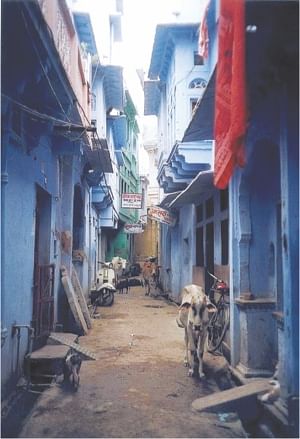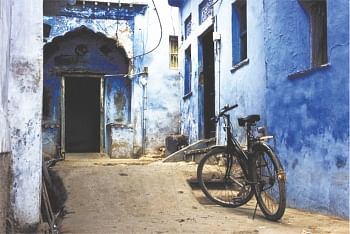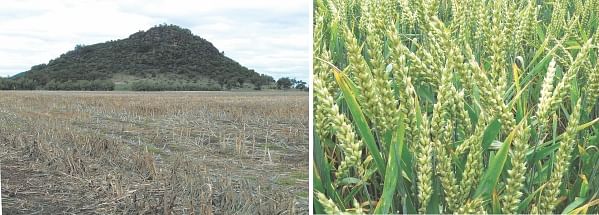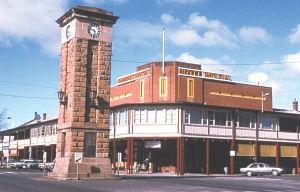| Home - Back Issues - The Team - Contact Us |
 |
| Volume 11 |Issue 09| March 02, 2012 | |
|
|
Travel
A Concise History of Cinema Andrew Eagle And…rolling! They barely touched in the days of Twinkle Khanna's debut, the hero and the heroine, as they sang and danced and sensually raised eyes to one another on their way through their love story. Even with machine guns while fighting the bad guys on the roof of a moving train there was time to dance. For the most part the choreography stemmed from the little yellow flowers in the sublime fields of the rolling hills which were otherwise not part of the setting. Heroines wore full saris back then; it was before the cost cutting on cloth. Cut! Scene two: for young western backpackers in Rajasthan a tour could not be complete without a visit to a cinema hall. There should be an introduction with at least one Kajol or Madhuri Dixit figure. Fades out…
When my mother was about twenty-five what they called the picture theatre was an entertainment hub in the small town of Coonabarabran, the only spot on the map for most of the one hundred kilometres in any direction, on the edge of the Australian outback. People gathered on a Wednesday and Saturday evening to touch base with Debbie Reynolds and Elizabeth Taylor. It was in the days when the hero and heroine barely touched and before the cost cutting on cloth. With less than four thousand people in the town a night at the pictures offered a view to the world beyond sheep stations and wheat fields. The word 'film' is generally considered to have two syllables in Coonabarabran: fil-em. Zooms in on wheat field… Scene four: Bundi in Rajasthan is not a large town, about eighty thousand people, and amongst its attractions is a solid cinema hall, the Ranjit Talkies. It's difficult to pass by. The scene was of a crowd that covered most of the area in front of the building on the day we tried to pass, vaguely forming two snaking queues. There was excitement. With curiosity and spare time to lead us to a close encounter with Bollywood, we joined the queue. It wasn't long before heads started turning and there were whispers. It's not every day there are foreigners in Bundi and it must be even rarer for them to attend the Ranjit Talkies. The queue seemed to have hardly any life to it but for us it didn't matter as somebody plucked us out and took us directly to the small window at the counter. We were guests. I believe it cost ten rupees, each ticket, and we had not realised that those were the most expensive seats available. We were guided like two of the Khans to mid-centre in the front row of the gallery. With the crowd filling the seats in the hall below and despite the full-volume continuing chatter, the fil-em was about to start. Add dramatic background music… In the Doris Days of my mother's trips to the picture theatre, my father had just arrived on the scene. He had come from Sydney as an engineer to partake in the building of Coonabarabran's water supply dam. Many years later when the river suffered from seasonal algae blooms and the water used to come out of the taps a green colour, I used to say to my grandmother, “you should call your son-in-law and ask him why the water from his dam is green.”
And how mother met father, well, in brief it's not unlike a 1960s Hollywood plot. There was a scene at a dance at the Buckley's Woolshed in Tooraweenah, and it can't be said of all couples that they first saw each other in a barn. And there were picture theatre evenings in the plot, with Vivien Leigh in re-runs and Julie Andrews singing and dancing, although her dance sequences lacked the syncopated Bollywood troops appearing from nowhere to further enliven the moment. Fades out… Scene seven: in the Kim Basinger and Dan Akroyd years as kids in Sydney we were more worldly, preferring serious documentaries like 'E.T.' and 'My Stepmother is an Alien,' and although there were instances of small round chocolates called jaffas taking advantage of the sloping wooden floor, with the sound of jaffas rolling adding a kind of ten-pin bowling ambience to the cinema near my place, we didn't talk through fil-ems. When the lights would dim, the audience would hush. In Bundi, the fil-em lasted a monumental three hours plus intermission, Bollywood usual, and it was not as passive an experience as in Sydney. People talked unashamedly which was good because the local guy beside me was able to discuss the on-screen events to ensure I was following the families-don't-agree-to-the-match-but-it-happens-anyway storyline. It was particularly caring that during the scene when the hero was wrestling a tiger he reassured that I should not be worried as it was only acting. It helped me understand why in some shots a large wooden pole could be spotted protruding from the tiger's back and why its limbs didn't seem to move. Cut to shot of tigers prowling… And when to make conversation I tried to explain that in Australia a movie ticket would cost the best part of ten dollars, my cinema companion became Amitabh angry. He understood the Ranjit Talkies' management had overcharged us, ten dollars, and was on the verge of leaping out of his seat to heroically run off downstairs to have it out with them in the foyer. Guests were really to be looked after at the Ranjit Talkies; fortunately I could clarify before the action scene started.
It wasn't only my father who had taken an interest in my mother, so the plot continued. There was also a pharmacist. My grandmother was concerned about my mother's reputation so she told her, in front of my father, to make a choice and see only one of them. “I agree with your mother,' my father chimed in, “and it should be me.' Well, my mother: she only could've done what Audrey would've done. Cut to close-up of heart-broken pharmacist…
In Bundi, the projector had a problem and at various moments the film burst into flame, the projector would shut down and the lights would be turned up. There was nothing for the audience to do while the Ranjit management fiddled about fixing things so they all turned around to focus on that other spectacle: the foreigners. They were waving and calling hello. Well, we only could've done what Shah Rukh would've done. We waved back, and I believe they applauded before the fil-em re-started. With tickets available at the Ranjit for just a few rupees we appreciated the importance of cinema: providing escape from the materially difficult lives that many in the audience presumably lived. Just as in Coonabarabran it was at the picture theatre where something beyond the routine of small town life could be enjoyed. In the world's largest democracy, across religions and languages Bollywood unites; and in Australia in the 1960s, in a cameo role, one mother and one father the Hollywood pictures helped unite. As would later occur in Eritrea after a wedding, on the following morning in Bundi as we walked down the street, someone called from across the road, “did you like the film?” Yes, we very much had, although there rightly should've been a song and dance routine to accompany our answer. That's a wrap! Copyright
(R) thedailystar.net 2012 |
||||||||||||||||




